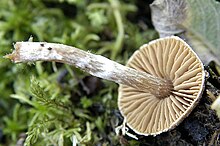
Cortinarius semisanguineus is a medium-sized mushroom with a pale brown to ochre cap, and bright blood-red gills. It belongs to the genus Cortinarius, a group collectively known as webcaps. It is found growing in conifer plantations, and has recently been given the fanciful common name of surprise webcap. In the past it has been called the red-gilled webcap.

Cortinarius mucosus, commonly known as the orange webcap or the slimy cortinarius, is a species of mushroom in the family Cortinariaceae. In North America, the species is more commonly associated with northern coniferous forests. The specific epithet is derived from the Latin word mucosus, meaning mucus.

Phlegmacium triumphans, also known as the birch webcap, or yellow girdled webcap is a basidiomycete mushroom in the family Cortinariaceae. It is found in Europe and regarded as edible by some authorities, although others call it suspect and it resembles inedible species.

Cortinarius violaceus, commonly known as the violet webcap or violet cort, is a fungus in the webcap genus Cortinarius native across the Northern Hemisphere. The fruit bodies are dark purple mushrooms with caps up to 15 cm (6 in) across, sporting gills underneath. The stalk measures 6 to 12 centimetres by 1 to 2 cm, sometimes with a thicker base. The dark flesh has a smell reminiscent of cedar wood. Forming symbiotic (ectomycorrhizal) relationships with the roots of various plant species, C. violaceus is found predominantly in conifer forests in North America and deciduous forests in Europe.
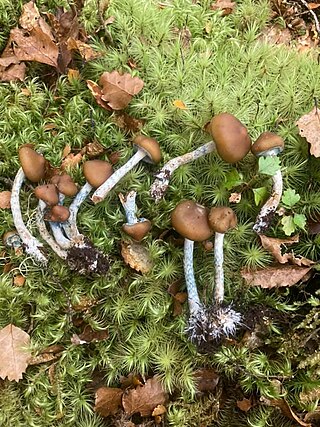
Psilocybe makarorae is a species of psilocybin mushroom in the family Hymenogastraceae. Officially described as new to science in 1995, it is known only from New Zealand, where it grows on rotting wood and twigs of southern beeches. The fruit body (mushroom) has a brownish cap with lighter coloured margins, measuring up to 3.5 cm (1.4 in) wide. The cap shape is either conical, bell-shaped, or flat depending on the age of the mushroom, and it features a prominent umbo. Although the whitish stem does not form a true ring, it retains remnants of the partial veil that covers and protects the gills of young fruit bodies. P. makarorae mushrooms can be distinguished from the similar North American species Psilocybe caerulipes by microscopic characteristics such as the presence of cystidia on the gill faces (pleurocystidia), and cheilocystidia with more elongated necks. Based on the bluing reaction to injury, P. makarorae is presumed to contain the psychedelic compounds psilocybin and psilocin.

Cortinarius varius, also known as the contrary webcap, is a basidiomycete mushroom of the genus Cortinarius. The mushroom has orangish-yellow caps that reach up to 10 cm (3.9 in) in diameter, and thick club-shaped stems up to 10 cm (3.9 in) long.

Cortinarius traganus, also known as the gassy webcap or lilac conifer cortinarius, is a basidiomycete mushroom of the genus Cortinarius. The mushrooms are characterized by their lilac color, the rusty-brown gills and spores, and rusty-brown flesh in the stem.
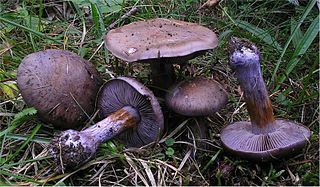
Thaxterogaster purpurascens is a species of mushroom producing fungus in the family Cortinariaceae. It is commonly known as the bruising webcap.

Cortinarius infractus, commonly known as the sooty-olive Cortinarius or the bitter webcap, is an inedible basidiomycete mushroom of the genus Cortinarius. The fungus produces sooty-olive fruit bodies with sticky caps measuring up to 13 cm (5.1 in) in diameter. The fruit bodies contains alkaloids that inhibit the enzyme acetylcholinesterase.

Cortinarius delibutus, also known as the bluegill webcap or the yellow webcap, is a basidiomycete fungus of the genus Cortinarius. The fruit bodies are medium-sized, with shiny yellow caps on a sticky, yellow-banded club-shaped stem. The mushroom is found in Europe and North America, usually near birch or beech trees.

Cortinarius cinnamomeus, also known as the cinnamon webcap, is a basidiomycete mushroom of the genus Cortinarius. The fungus produces brown fruit bodies with caps up to 6 cm (2.4 in) wide and stems up to 12 cm (4.7 in) long. The closely crowded gills underside the cap are initially yellow before turning brown. Cortinarius cinnamomeus is common in damp places in coniferous forests. It is distributed throughout the temperate zone of the Northern Hemisphere.

Cortinarius anomalus, also known as the variable webcap, is a basidiomycete fungus of the genus Cortinarius. It produces a medium-sized mushroom with a grayish-brown cap up to 5 cm (2 in) wide, gray-violet gills and a whitish stem with pale yellow belts below. The mushroom grows solitarily or in scattered groups on the ground in deciduous and coniferous forests. It is found throughout the temperate zone of the northern hemisphere.
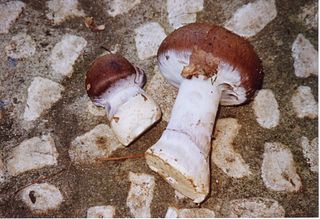
Cortinarius praestans, also known as the goliath webcap, is a basidiomycete mushroom of the genus Cortinarius. The mushroom has orangish-yellow caps that reach up to 20 cm (7.9 in) in diameter, and thick club-shaped stipes up to 15 cm (5.9 in) long. The edible mushroom is found in Europe.

Cortinarius camphoratus, commonly known as the goatcheese webcap, is an agaric fungus in the family Cortinariaceae. The fungus is found in Europe and North America, where its fruit bodies (mushrooms) grow on the ground in a mycorrhizal association with spruce and firs in coniferous forests. Mushrooms are characterized by pale blue lilac colors when young, and a strong distinctive odor. Sources disagree as to the edibility of the mushroom, but they are generally not recommended for eating.
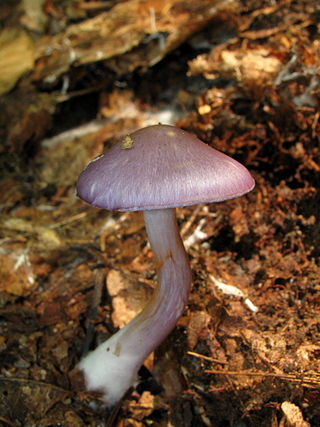
Cortinarius iodes, commonly known as the spotted cort or the viscid violet cort, is a species of agaric fungus in the family Cortinariaceae. The fruit bodies have small, slimy, purple caps up to 6 cm (2.4 in) in diameter that develop yellowish spots and streaks in maturity. The gill color changes from violet to rusty or grayish brown as the mushroom matures. The species range includes eastern North America, Central America, northern South America, and northern Asia, where it grows on the ground in a mycorrhizal association with deciduous trees. The mushroom is not recommended for consumption. Cortinarius iodeoides, one of several potential lookalike species, can be distinguished from C. iodes by its bitter-tasting cap cuticle.
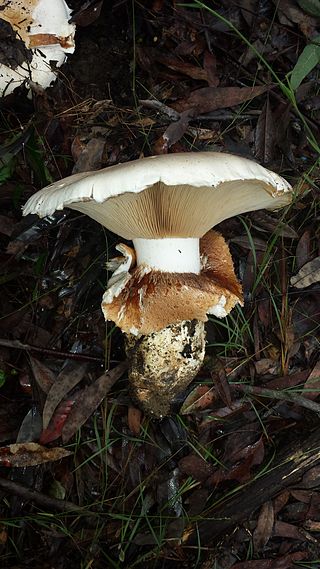
Austrocortinarius australiensis, commonly known as the skirt webcap, is a species of mushroom in the family Cortinariaceae which is native to Australia and New Zealand. The white mushrooms appear in autumn and can grow very large, with their caps reaching 30 cm (12 in) in diameter.
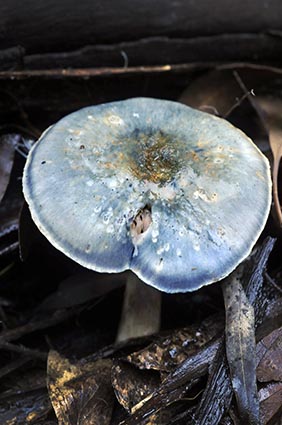
Cortinarius metallicus, originally described as Rozites metallica and commonly known as the steel blue rozites, is a species of mushroom native to Australia.

Cortinarius elatior is a species of mushroom native to Europe which is commonly known as the wrinkled webcap due to the cap's tendency to wrinkle with age.
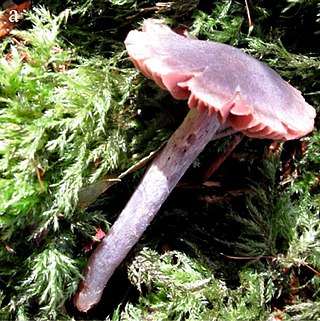
Cortinarius britannicus is a species of webcap. It is known only from Scotland, where it was found on clay soil among mosses under beech. The species produces small, purplish mushrooms. Along with five other British webcaps, C. britannicus was selected by Kew Gardens as a highlight of taxa described by the organisation's staff and affiliates in 2020.

Cortinarius heatherae is a species of webcap. It was described in 2020 by Andy Overall from a specimen found at Heathrow Airport. He named the species in honour of his wife, Heather Overall. Along with five other British webcaps, C. heatherae was selected by Kew Gardens as a highlight of taxa described by the organisation's staff and affiliates in 2020.

